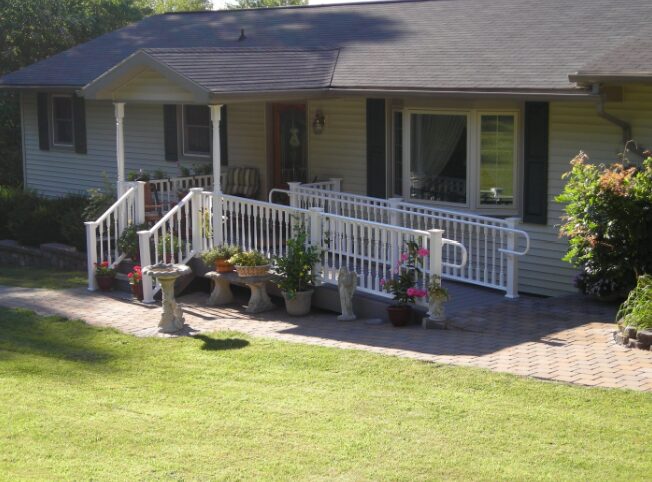For home buyers with mobility challenges, finding a move-in ready home can be tough. Even if the market picks up in 2025, as many experts predict, finding a home that already has safe, accessible outdoor spaces with railings, ramps, and walkways is a lot more difficult than finding the right real estate agent or the lowest real estate commission rate.
Having these safety features added to a home isn’t as expensive or time-consuming as you might think, as long as you keep a few basic principles in mind.
The right walkways
For homeowners with mobility challenges, conventional yard or garden walkways made of gravel, wood chips, or dirt can pose a safety risk. All of these materials are uneven and unstable, which can lead to tripping, stumbling, and falls. This instability can increase exponentially when you add rain or snow to the equation.
Materials like wood or paving stones are better but present similar problems. Wood can be very slick when wet and requires a lot of maintenance to stay in a good, safe condition. Paving stones or bricks can shift after installation, becoming tilted or slanted. Even with perfectly installed, tightly fitted bricks or paving stones, small, naturally occurring cracks or gaps can be a tripping hazard, especially to someone who uses a cane, walker, or wheelchair.
If you must use bricks or pavers, make sure you lay them down on a very flat, even foundation, and put dry polymeric sand between the stones to create a flush, even surface, which will also help to discourage weeds.
The best material for an accessible outdoor walkway is concrete because it’s a smooth, durable, and non-slip material that doesn’t require a lot of maintenance. It can be installed in larger segments that will minimize potentially dangerous cracks, and it’s nearly weatherproof.
Concrete, however, isn’t completely immune to damage. Nearby trees can fracture concrete walkways from below as their roots grow.
Whatever material you choose, consider making your pathways extra wide to accommodate mobility devices or two people walking side by side. While 36 inches is standard, 48 inches is even better.
Pay special attention to transitions between your walkway and existing paths, too. There should be a smooth, gradual transition with no sudden changes in elevation, slope, or stability.
The right ramps
A ramp is one of the most dependable ways to increase your home’s accessibility to those who have mobility challenges, but it can be a bit more difficult to install than a walkway.
When it comes to materials, concrete is again the best choice. Concrete is durable, smooth, and requires little maintenance. The main drawback with a concrete ramp is the expense, and if you opt for a concrete ramp, doing it yourself is likely out of the question.
If you’re intent on a self-installed ramp, aluminum ramps can be installed by someone who is moderately handy, and they are less expensive than a concrete ramp. They’re also light and will last quite a while, even in wet climates. Wood is another popular choice for ramps and can be the most aesthetically pleasing choice if it matches the home’s siding or the front door, but it’s susceptible to rot if it’s not properly sealed.
It’s also important to get the ramp’s slope right. If you make it too steep, ascents will be difficult, and descents could be downright dangerous. If it’s not sloped enough, the ramp will be too long, and transitions will be a problem.
Experts suggest a slope ratio of 1:12, which translates to 12 inches of ramp length for every 1 inch of rise. If you have 24 inches of stairs in front of your home, you’ll need a ramp at least 24 feet long.
For additional safety, build a few landings where people can rest or reorient themselves for the next stretch of ramp.
Consider railings
Putting in railings is one of the most effective and cost-efficient ways to make your home safer for the mobility challenged. Consider putting railings on both sides of a staircase so they can be easily used going up and down. Make sure they’re firmly and properly installed, too. A railing must be able to handle a good amount of direct weight to provide safe assistance.
Visibility and lighting
Finally, don’t overlook lighting. A safe, perfectly installed ramp or walkway can be undermined by poor lighting. Install motion-activated lights along paths or ramps, especially where surfaces are uneven or potentially unsafe. Another effective visibility measure is using contrasting colors or textures to mark the edges or ends of paths.
6 Tips for Aging in Place or Universal Design
Designing Open Floor Plans: How to Maximize Mobility and Accessibility for Aging Adults
How to Choose Flooring and Layouts for Fall Prevention and Comfort


